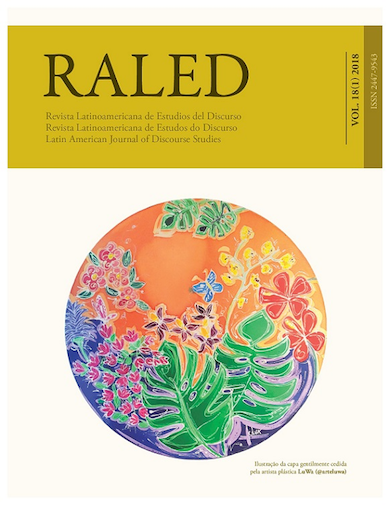Resistance Music
Discursive constructions through son jarocho in California
Keywords:
political music. hidden transcript. identity. resistance. representation.Abstract
Son jarocho is a sociocultural phenomenon emerged from Veracruz, Mexico. Understood as a musical genre within globalization, son jarocho is listened, practiced, and re-signified in different parts of the world. Since the 1990’s of the twentieth century, the relations between people of Veracruz and Chicanos from California have intensified around son jarocho. Te general objective of this paper is to study the discursive structures, manifested in terms of cultural and political resistance, in four Chicano groups from Los Angeles, California: Quetzal, Las Cafeteras, Cambalache and Chicano son. Some concepts of Critical Discourse Analysis (CDA) were used to show the relationships between social structures and discursive structures. The fundamental concepts were: political music, by Dunaway (1987); identity, by Giménez (2005); discourse, by van Dijk (2000) and Scott (2000); and representation, by Hall (2011). The results obtained from the analysis of four songs are shown below.
Downloads
References
ARISTEGUI, C. 2013. [Disponible en línea en https://aristeguinoticias.com/0804/mundo/censo-revela-que-en-eu-viven-33-6-millones-de-personas-de-origen-mexicano/]. Censo revela que en EEUU viven 33.6 millones de personas de origen mexicano. [Consulta: 2 de febrero de 2018].
CALSAMIGLIA, H. Y TUSÓN, A. 2007. Las cosas del decir. Manual de análisis del discurso. Barcelona: Ariel.
CARDONA, I. 2011. Fandangos de cruce: la reapropiación del son jarocho como patrimonio cultu-ral. Revista de Literaturas Populares 9, 1: 130-146.
CARDONA, I. Y RINAUDO, C. 2017. Son jarocho entre México y Estados Unidos: definición “afro” de una práctica transnacional. Desacatos: Revista de Antropología Social 53: 20-37.
ASTRO, C. 2013. Una historia de fandango. Los Ángeles, California: Greenham at Infrasonic Sound.
CHICANO SON. 2015. [Disponible en línea en http://chicanoson.com/music/]. El golpe. [Consulta: 5 de marzo de 2015].
CHILTON, P. Y SCHÄFFNER, C. 2000. Discurso y política. En T. Van Dijk (comp.). El discurso como interacción social, pp. 297-329. Barcelona: Gedisa.
DUNAWAY, D. 1987. Music and politics in the United States. Folk Music Journal 5, 3: 268-294.
EZLNY BFZ. 1998. Quetzal. San Francisco, California: Son del barrio.
FIGUEROA, R. 2007. Son jarocho. Guía histórico-musical. México: CONACULTA.
FIGUEROA, R. 2014. El son jarocho en los Estados Unidos de América. Globalizaciones, migraciones e identidades. Xalapa: Universidad Veracruzana.
FRITH, S. 2011. Hacia una estética de la música popular. En F. Cruces (comp.). Las culturas musi-cales. Lecturas en etnomusicología, pp. 413-435. Madrid: Trotta.
GIMÉNEZ, G. 2005. Teoría y análisis de la cultura. México: CONACULTA”“ICOCULT.HALL, S. 2011. Introducción: ¿quién necesita identidad? En S. Hall y P. Du Gay (comps.). Cuestiones de Identidad, pp. 13-39. Buenos Aires: Amorrortu Editores.
HERNÁNDEZ-LEÓN, R. 2013. Cambalache y el intercambio chicano-jarocho. Una historia de fandan-go. Los Ángeles, California: Greenham at InfrasonicSound.
KCET. 2013. [Disponible en línea en http://www.kcet.org/shows/live_at_the_ford/flores-magon/blog-3/chicano-son.html]. Variedades: the ballad of Ricardo Flores Magón. [Consulta: 2 de mayo de 2015].
KRÜGER, S. 2008. Ethnography in the Performing Arts A Student Guide. Liverpool: Palatine.
LAS CAFETERAS. 2012. It’s time. Los Ángeles, California: Bedrock Studios.
LOZA, S. 1993. Barrio Rhythm. Mexicanamerican music in Los Angeles. Illinois: University of Illinois Press.
MACIEL, D. y BUENO, P. 1975. Aztlán. Historia del pueblo chicano (1848/1910). México: Secretaría de Educación Pública.
OGAS, J. 2013. Nombrando Latinoamérica. Revolución y resistencia desde la nueva canción al hip-hop. Musiker 20: 275-297.PÉREZ, H. 1995. En pos del signo. Introducción a la semiótica. Zamora: El Colegio de Michoacán.
SÁNCHEZ-TELLO, G. 2012. Jaraner@: Chicana/o acculturation strategy. Northridge: California State University.
SCOTT, J. 2000. Los dominados y el arte de la resistencia. México: Ediciones Era.
TEWKSBURY, D. 2013. [Disponible en línea en http://www.kcet.org/arts/artbound/counties/los-an-geles/chicano-son-music.html?utm_source=Twitter&utm_medium=Social&utm_campaign=Art-bound]. Chicano/Son. KCET [Consulta: 2 de diciembre de 2014].
VALENZUELA, J. M. 1998. El color de las sombras. Chicanos, identidad y racismo. México: Colegio de la Frontera Norte - Universidad Iberoamericana - Editorial Plaza y Valdés.
VAN DIJK, T. A. 2000. El estudio del discurso. En T. A. Van Dijk (comp.). El discurso como estruc-tura y proceso. Estudios sobre el discurso I. Una introducción multidisciplinaria, pp. 21-65. Barcelona: Gedisa.
VAN DIJK, T. A., TING-TOOMEY, S., SMITHERMAN, G. y TROUTMAN, D. 2000. Discurso, filiación étnica, cultura y racismo. En T. A. Van Dijk (comp.). El discurso como interacción social, pp. 213-262. Barcelona: Gedisa.
Downloads
Published
How to Cite
Issue
Section
License

This work is licensed under a Creative Commons Attribution-NonCommercial-NoDerivatives 4.0 International License.
The authors retain the copyright and guarantee RALED the right to be the first publication of the work as well as a Creative Commons Attribution License that allows others to share the work with recognition of authorship and the initial publication in this journal.




